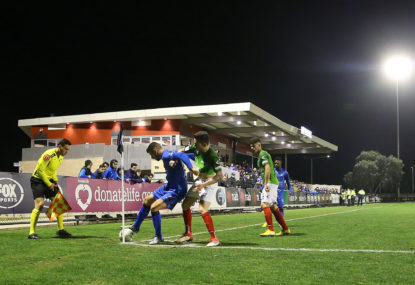If more Australians are watching the A-League these days than the English Premier League it presents something of an opportunity for Australian football.
No doubt the time zone must play a role, as does the unreliable streaming of the English content via applications. Moreover, its limited presence on commercial television does the league no favours whatsoever.
It is fair to suggest that this situation will continue in the short term. After the technological and public relations disaster of #floptus, it is hard to imagine there will be a flood of new subscriptions leading into the launch of the English domestic season this weekend.
With the rights snatched away from Foxtel for the 2016-17 season and a recent extension seeing the league locked away with Optus until 2022, the A-League can potentially prosper without direct television competition from the biggest league in the world.
The Roy Morgan data of 2016, around the time of the stunning scoop Optus made on the rights, reported that the local competition was already out stripping the Premier League when it came to regular viewing in Australia.
The data identified a 50 per cent increase in the A-League viewing audience between 2011 and 2016 and also alluded to a bump in the numbers as soon as SBS began sharing a portion of the broadcasting duties in 2013-14.
While 2017-18 will be remembered as an abject disappointment for the A-League when it came to attendance and television ratings, the general upward trend since 2011 will hopefully continue off the back of the ‘magic’ being produced by the FFA Cup.
There is an interesting comparison to be made between Australia’s infantile and blossoming domestic cup competition and the storied nature of the English equivalent.
With Champions and Europa League football now ever present staples, domestic cup competitions appear to be battling with identity. The English version is an obvious example.
With the considerable resting of players, poor scheduling and only the lure of Europa League participation for the winner, it is no wonder the once hallowed competition is not as it was.
Contrastingly, Australia’s version where 781 teams throw their hat in the ring for a chance at history, is starting to look a little ominous. The English version appears stale and tired while our local product is in its infancy.
Even with Optus opening up its customer base to the entire community with its new monthly subscription service, the FFA Cup will continue to surge ahead if English football remains well hidden under Harry Potter’s invisibility cloak.
It is somewhat educative to compare the astronomical numbers that surround English football, its FA Cup and Australia’s little competition, which is driven by amateur participation.
The Premier League is a cash cow for many, at the expense of much of what is pure and honest about the game itself, its origins and the value of community and local involvement.

Chelsea members celebrate (IAN KINGTON/AFP/Getty Images)
It is a difficult thing for those clubs to engage with the knock-out competition in the spirit intended; such are their commercial realities.
Contrastingly, whilst appearing a little contrived and its importance over-inflated back in 2014 when it was born, within four years, the FFA Cup has become something quite special.
Sure it is still a little boutique and quirky at times, but any criticism in that direction appears to be missing the point. It is unique, local and tinged with the spirit and passion of the destitute underdog, grappling with the top end of town and that is something to be celebrated.
It is that David and Goliath scenario that brings the ‘magic’ of which the hashtag of the competition continues to remind us all.
It is that exact sentiment that the FA Cup appears to have lost, as the heavyweights employ the use of Squad B to surge through the fourth and fifth rounds.
Gone are the days of Coventry City in ‘87, the Elton John fuelled Watford of ‘84 and the decade prior, that saw three second tier teams claim the silverware.
The Round of 32 matches in the FFA Cup on Tuesday, took us back to the future and captured all the integrity and intended fun of cup competition.
Whilst the stern and disappointed faces of the Perth Glory and Brisbane Roar players reflected the professional side of the competition, the beaming smiles on the Bentleigh Greens’ squad captured that sense of fun after their ten-man, 1-0 victory against the Phoenix.

Avondale vs Marconi (Photo by Scott Barbour/Getty Images)
Similarly, Devonport City set up an away trip to Avondale FC after a 3-1 win against Northcote City and Hellenic Athletic pushed the Wanderers all the way in a 3-4 loss at Larrakia Park Football Stadium in the Northern Territory.
Perhaps the most fitting of all upcoming matches in the Round of sixteen will be when the Bonnyrigg White Eagles welcome the Wanders to their home patch in the west of Sydney.
There is a significant buzz and interest in the FFA Cup. Feel good stories are worth their weight in gold and the engagement with community through the local clubs is proving a boon for those whose vision brought the competition to life.
[latest_videos_strip category=”football” name=”Football”]
Some Australians were frustrated by Optus’ inability to provide reliable pictures from Russia and many are disappointed by the increased technological distance between the world’s richest league and their homes.
However, the burgeoning success of the FFA Cup and more Australians than ever watching the A-League, suggest that the current broadcast structures in place might be doing Australian football the biggest favour of all.































































































